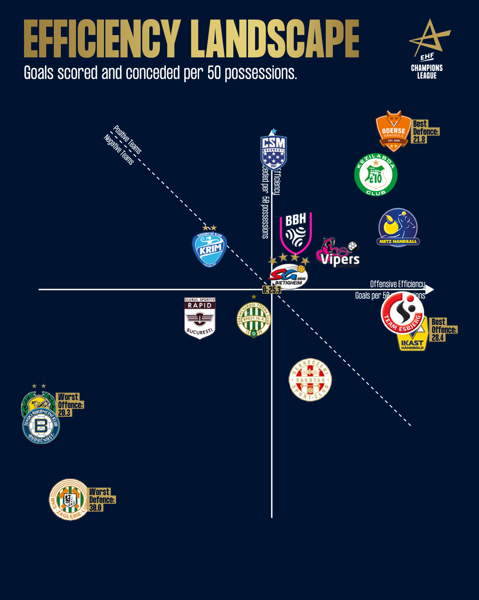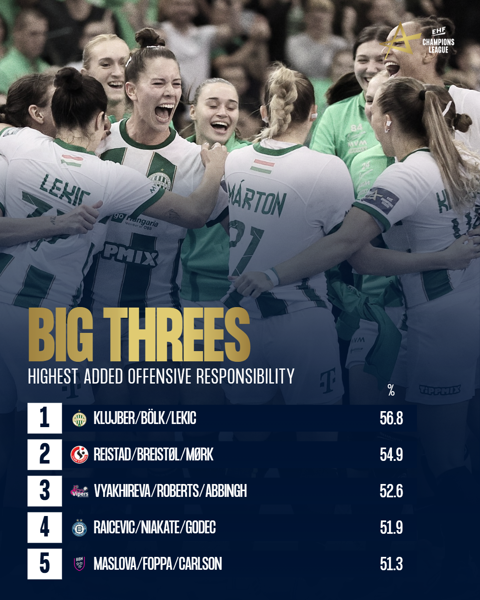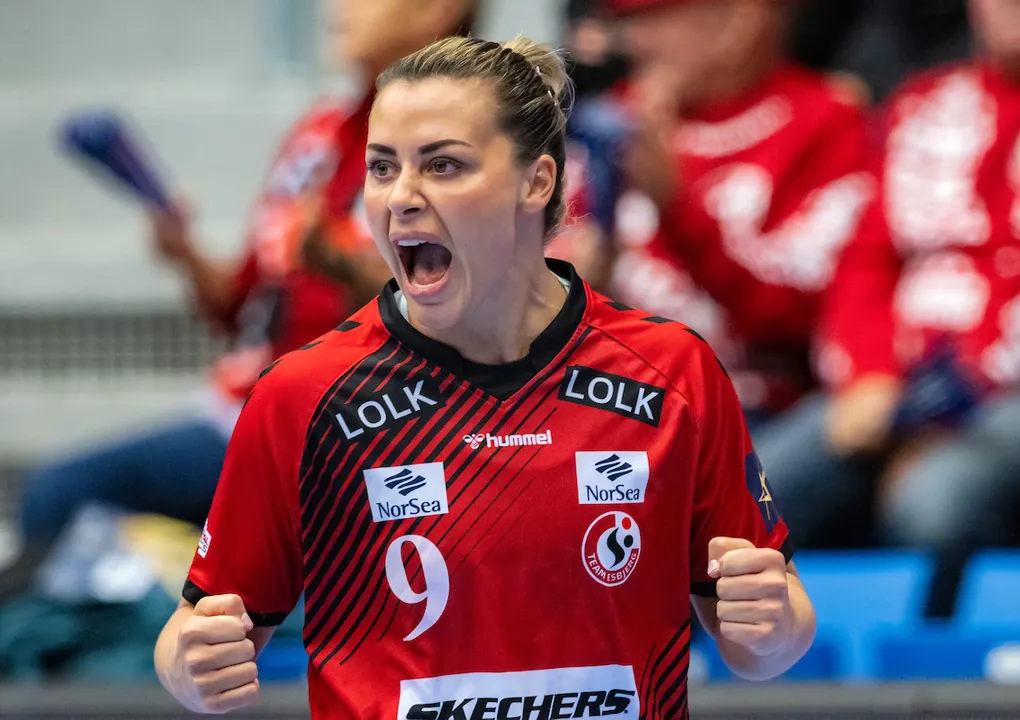Team Esbjerg are once again an offensive juggernaut. After having the best offence in the EHF Champions League last season scoring 29.0 goals per 50 possessions, they rank second this year with 28.2. Currently, only Ikast Handbold’s attack is better with 28.4 goals per 50 possessions. Defensively, on the other hand, at 25.8 goals conceded per 50 possessions, they are only average - also similar to the previous year.

Using these statistics that are adjusted for possessions played is significantly more meaningful than just the raw number of goals (conceded), because it makes the teams actually comparable since the raw number of goals is not only influenced by efficiency, but also by the number of possessions (whether a team and their opponents play rather fast or slow). Since a game has roughly 50 possessions on average (53.1 this season), the values here are calculated on 50 possessions so that they roughly reflect those of a game.
So, while there is still room for improvement on the defensive end, coach Jesper Jensen has really figured out how to use Henny Reistad and her teammates perfectly in attack. Looking at the details, the team from the west coast of the Jutland Peninsula excels in one offensive category, but is good everywhere.
They have the fourth-fewest turnovers with 8.8 per 50 possessions and the sixth-best shooting percentage at 63.7 per cent. If you break down the latter, they shoot 62.4 per cent from the field (fifth place) and 82.2 per cent from seven-meter penalties (third-best). In addition, they have the luck of the brave and, with an 18.8 per cent share of offensive rebounds after missed shots, are the team with the most second chances.
The big three
The three most important players for the team that finished fourth last season are Henny Reistad, Kristine Breistøl and Nora Mørk. Reistad is responsible for the end of 20.4 per cent of her team’s attacks by shooting from the field, receiving a seven-meter, or turning the ball over. That’s the highest of the team and the sixth-highest of the EHF Champions League.
Breistøl ranks second in her team and tenth in the EHF Champions League with 19.2 per cent. The “big three” are completed by their backcourt partner Mørk with 15.3 per cent. This gives them a combined share of 54.9 per cent. Only one team has a higher number than the three most used players in offence: Esbjerg's quarter-final opponents FTC-Rail Cargo Hungaria.
The offensive responsibility numbers of FTC’s trio of Katrin Klujber (21.7 per cent, third overall), Emily Bölk (19.1 per cent) and Andrea Lekic (15.9 per cent) adds up to 56.8 per cent. This means that Saturday's Match of the Week between Esbjerg and FTC will be a clash of the two “big threes”.

Correspondingly, with 6.3 goals per game, Reistad is not only her team's most successful scorer, but also ranks fourth in the competition. Looking only at shots from the field, 6.1 even puts her in third place. Although she is not quite as efficient as last season, 62.4 per cent from the field, she still has the fifth-best figure among all 40 backcourt players with at least 5.0 shots per game.
But it is not only Reistad who stands out. At least from the seven-meter line, Mørk also has outstanding numbers. After some problems last season, she is now the most efficient among all 14 high-volume seven-meter shooters with at least 2.0 attempts per game with 88.6 per cent.
Findings from the encounters in the group stage
The clash of the “big threes” has already taken place twice this season in the group stage. Or rather should have taken place because Reistad missed the home game. Nevertheless, both times Esbjerg, who finished their group second, while FTC ended up sixth, won.
Accordingly, the Danes go into their quarter-final duel as clear favourites. However, there are also points from the two clashes in the group stage that can encourage FTC. In the game in Denmark, they forced Esbjerg to produce their second-worst attacking performance of the season with 25.0 goals per 50 possessions. At 58.7 per cent, they had their fourth-worst shooting percentage and with 12.0 turnovers per 50 possessions the third-most this season.
Jesper Jensen’s team lost the ball even more often in the second encounter with FTC, where they were much more successful in finishing (73.3 per cent, their third-best performance of the season). They have to push and exploit this even more in order to score easy goals through counter-attacks. However, FTC is not exactly known for its fast handball this season. With an average of 34.5 seconds, their possession times are the third longest this season. Only 24.0 per cent of their possessions ended in less than 20 seconds, the fourth-lowest.
On the other side, in both matches together Esbjerg didn’t miss one seven-meter attempt and it should not be forgotten that Esbjerg's most important player, Henny Reistad, was missing from the first encounter. On Saturday, however, the IHF World Player of the Year should be on the field. With ten goals on 13 attempts (all from the field), the 25-year-old dominated the clash in Budapest and set her season’s best. So, to have a chance, FTC must do everything in their power to get her under control somehow.
This weekend's MOTW, the quarter-final first leg between FTC-Rail Cargo Hungaria and Team Esbjerg throws off at 16:00 CEST, live on EHFTV, with commentary in English from Nina Bargel-Neuhaus - the first time the EHF Champions League Women's coverage has featured English commentary outside of an EHF FINAL4 event.
More from data analyst Julian Rux can be found at Handballytics.de. There you can read his latest articles, in which he analyses all kinds of handball topics from new, data-based perspectives. You can also find him on Instagram, Facebook, X/Twitter, Threads and WhatsApp Channels.
Main photo © Niels Husted








